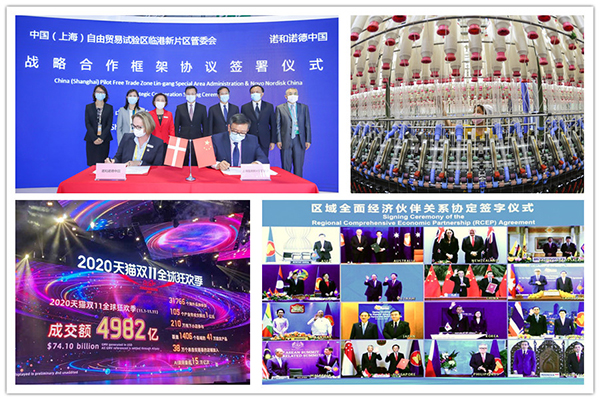Major economic policies to boost recovery in 2020

Editor's note: China's economy has not only recovered quickly but \r\nalso made a great contribution to world economic development despite the\r\n COVID-19 pandemic, thanks to the wisdom of and effective measures taken\r\n by the Chinese government.
Let's take a look at some of the major economic policies to boost recovery in 2020.
I Implementing Foreign Investment Law
The Foreign Investment Law took effect in China starting Jan 1 to \r\nbetter protect the interests of foreign investors in the country.
China is taking more steps to open up its economy to foreign \r\ninvestors, as it aims to further facilitate investment and spur growth \r\ndespite disruptions from the COVID-19 pandemic.
II Establishing dual-circulation development paradigm
The Fifth Plenary Session of the 19th Central Committee of the \r\nCommunist Party of China proposed that China seek to establish a \r\ndual-circulation development paradigm.
The dual circulation development paradigm, China's medium- and \r\nlong-term development strategy, focuses on domestic and overseas markets\r\n reinforcing each other, with the domestic market as the mainstay.
III Ensuring six priorities and stability in six areas
The central government has reiterated that fiscal funds should be used to ensure the focus remains on the "six priorities":
Employment
People's livelihoods
Development of market entities
Food and energy security
Stable operation of industrial and supply chains
Smooth functioning at the community level
and to ensure stability in six areas:
Employment
Finance
Foreign trade
Foreign investment
Domestic investment
Market expectations
IV Continuing to cut taxes and fees
The Ministry of Finance continues to implement the tax and fee cut \r\npolicy this year, researching new measures to ease the tax burden of \r\nenterprises affected by the novel coronavirus outbreak.
In the first three quarters of this year, a total of more than 2 \r\ntrillion yuan of new tax and fee cuts were made across the country, \r\naccording to the State Taxation Administration.
V Signing RCEP - a landmark achievement of East Asian regional cooperation
After eight years of unremitting efforts, the Regional Comprehensive \r\nEconomic Partnership agreement was formally signed on Nov 15.
The signing of the pact highlights that open cooperation is still a \r\nhistorical trend and joint efforts to reach mutually beneficial and \r\nwin-win results are still popular.
The signing of the RCEP will help remove obstacles in the ongoing \r\nnegotiations for a trilateral free trade agreement between China and its\r\n partners.
VI Establishing the Hainan free trade port and three new free trade zones
China rolled out a master plan in early June on building the southern\r\n island province of Hainan into a globally influential free trade port.
China also approved three new pilot free trade zones in Beijing, \r\nHunan and Anhui in September, increasing the total number of FTZs to 21.
VII Cutting negative lists for foreign investment
China has unveiled new, shortened negative lists for foreign \r\ninvestment, as part of efforts to further open up the economy and \r\nimprove its business environment.
The number of sectors that are off-limits to foreign investors has \r\nbeen cut to 33 in the 2020 version of the negative list from 40 in the \r\n2019 version.
China also unveiled its 2020 negative list for foreign investment in \r\npilot FTZs, cutting the number of prohibited industries to 30 from 37. \r\nThe two new negative lists took effect on July 23.
VIII Boosting consumption
China on March 13 announced targeted measures to boost consumption, \r\nincluding improving the consumer market supply and speeding up the \r\nconstruction of a smart consumption ecosystem.
The country outlined 19 measures to help promote higher quality and \r\nan expansion of capacity in the consumption sector as well as foster a \r\nrobust domestic market.
IX Cutting the reserve requirement ratio
The central bank has made across-the-board and targeted RRR cuts to \r\nsupport the development of the real economy and reduce the actual cost \r\nof social financing.
Sources: The People's Bank of China, Ministry of Finance, State Taxation Administration, Xinhua and China Daily

